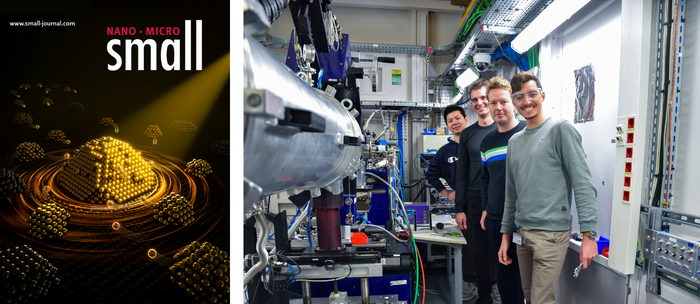Do you want to keep up to date? Subscribe to our newsletter. 1 mail every 2 months! |
 |

Left: The study has been selected for the cover of the scientific journal Small. Right: Researchers inside the experimental hutch of the NCD-SWEET beamline at the ALBA Synchrotron. From left to right: Zhiwei Zhang (Ghent University), Matthias Minjauw (Ghent University), Matthias Filez (Ghent University - KU Leuven) and Juan Santo Domingo Peñaranda (Ghent University).
Cerdanyola del Vallès, February 2, 2023. Metal nanoparticle catalysts are the workhorses in a broad range of industrially important chemical processes such as producing clean fuels, chemicals and pharmaceuticals or cleaning exhaust from automobiles. These nanocatalysts are key for the future of sustainable chemistry, yet they typically suffer from rapid deactivation caused by a process called sintering. Due to sintering, the average nanoparticle size increases since this is energetically more efficient for the nanoparticles. However, this decreases their catalytic power.
To date, sintering phenomena are analyzed either at the macroscale, to examine averaged nanoparticle properties, or at the microscale, studying individual nanoparticles. However there is a knowledge gap on the nanocatalysts behavior at the mesoscale, the intermediate length scale between the macro and the micro worlds. At the mesoscale, large ensembles with thousands of nanoparticles can be studied as a “population” in which nanoparticles “communicate” – interact - with each other. In this context, nanoparticle sintering can be considered as a dynamic population of interacting nanoparticles, each of them trading and exchanging atoms to gain stability within the nanoparticle hierarchy.
In a recent study led by the ALBA Synchrotron and Ghent University, researchers have developed an integrated approach where they complement the use of several characterization techniques to study platinum nanoparticle sintering at the micro-, meso- and macroscale. More specifically, they used different analytical techniques and X-ray scattering characterization at the NCD-SWEET beamline in ALBA to show that mesoscale heterogeneities in the nanoparticle population drive sintering. Thus, deleting these heterogeneities would help to avoid sintering.
This work, published in the scientific Journal Small and selected to be on the front cover, will help broaden the fundamental understanding of nanoparticle sintering and thus, design better strategies for catalyst fabrication.
Integration of multiple characterization techniques
High-resolution scanning electron microscopy (HRSEM) combined with Monte Carlo simulation enabled to study sintering across the entire population of nanoparticles, and on the level of single nanoparticles and their local mesoscale environment, respectively. Results showed that the size evolution of individual nanoparticles is strongly dependent on the nanoparticle’s mesoscale environment, where local population heterogeneities generate nanoparticle-rich “hotspots” and nanoparticle-free zones during sintering.
“A Monte Carlo model was developed and validated by linking it to experimental images of the nanoparticles and their local environment. This model showed how nanoparticles change during their catalytic lifetime, and how their size evolves by exchanging atoms with their neighbors, or by colliding and growing together. By visualizing the evolution of many nanoparticles, several sub-groups could be classified which all behave differently. Tackling the reasons for sintering based on this analysis provides guidelines for future synthesis.” Describes Matthias Filez, postdoctoral researcher at Ghent University and KU Leuven and corresponding author of the paper.
In situ grazing-incidence wide-angle X-ray scattering (GIWAXS) was carried out at the NCD-SWEET beamline in the ALBA Synchrotron. The technique was applied for the first time to track sintering in real-time with sensitivity to large and small nanoparticle sub-populations separately in a single experiment, uncovering their respective properties and behavior, as well as their mutual dynamic interplay. Results showed that not all nanoparticles within the small nanoparticle sub-population are equally prone to sintering, depending on their crystallographic orientation on the support surface.
“The use of synchrotron light enabled the possibility to follow the evolution of the different families of nanoparticles at the same time while applying conditions that are relevant for real world applications. This would not be possible without the bright synchrotron X-ray beam, since we would be blind to the changes of the nanoparticles in real time, limiting the science and advances that we would be able to perform.” Explains Eduardo Solano, scientist at the NCD-SWEET beamline in ALBA and first author of the paper.
Reference: Eduardo Solano, Jolien Dendooven, Davy Deduytsche, Nithin Poonkottil, Ji-Yu Feng, Maarten B. J. Roeffaers, Christophe Detavernier, and Matthias Filez. Metal Nanocatalyst Sintering Interrogated at Complementary Length Scales. Small (2022). DOI: 10.1002/smll.202205217
With the collaboration of Fundación Española para la Ciencia y la Tecnología. The ALBA Synchrotron is part of the of the Unidades de Cultura Científica y de la Innovación (UCC+i) of the FECYT and has received support through the FCT-21-17088 project.





